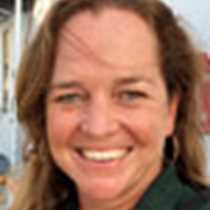Isabela and Fernandina
A long overnight sail took us away from the central archipelago to a new world – both literally and figuratively! Both the scenery and wildlife are completely different in western Galápagos than anything else in the world, and these islands are very new, less than 700,000 years old, being situated right over the Galápagos hot spot.
We came out on deck at daybreak, to see the sun coming up over the tall shield volcanoes of Isabela and Fernandina. These volcanoes are formed mainly from effusive lava flows, however show a distinctive shape – with an increase in the slope gradient towards the summit – that have earned these Galápagos volcanoes the nickname “inverted soup bowls.” While enjoying the scenery and flat calm seas, our Captain spotted some bird activity in the distance. On approaching to investigate, we saw that among the dense flock of Galápagos shearwaters and noddy terns, a large group of common dolphin were surfacing. As we approached, to our delight, they started leaping out of the water with a great show of acrobatics that allowed us to fully enjoy the grace of these animals and their pretty markings.
We then continued on our route, despite another brief detour to try and get a better look at a couple of small whales spotted by one of the kids on board, which remained, however, unidentified. After breakfast, we crossed the Equator, and all Pollywogs were summoned on to our bridge deck by King Neptune and his fearful pirates, and baptized as Shellbacks in order for us to continue on our journey through these tropical waters.
After sailing along the coast of an impressive volcano, half of which had collapsed away into the depths due to localized faulting thus allowing us to gaze into the exposed caldera, National Geographic Islander anchored in a sheltered bay at the base of these cliffs. We dropped the Zodiacs and took a ride in the area, with sightings of Galápagos penguins, Galápagos fur seals, flightless cormorants, oceanic sunfish, countless turtles and more. Tide was low, which allowed us to enjoy an impressive exposed intertidal zone, covered in countless colorful invertebrates. A highlight was a look at the beautiful red sun star – an endemic species that almost disappeared during the 97/98 El Niño phenomenon, but that fortunately is making a come-back of late.
After lunch, our young explorers gathered in the lounge to complete one of many steps in the contest to become Junior National Geographic-Lindblad Expeditions Naturalist: training in nautical knot tying with our Helmsman Victor. We later disembarked to hike on the youngest, most pristine island in the group, Fernandina. Sea lions had given birth all over the place, and dozens of tiny pups bleated for their mothers’ milk. Enormous, dragon-like marine iguanas worshipped the sun, to replenish warmth lost during their diving for algae. And the bizarre flightless cormorants were everywhere, on shore heating up and in the water, diving for food and starting complex courtship rituals.




